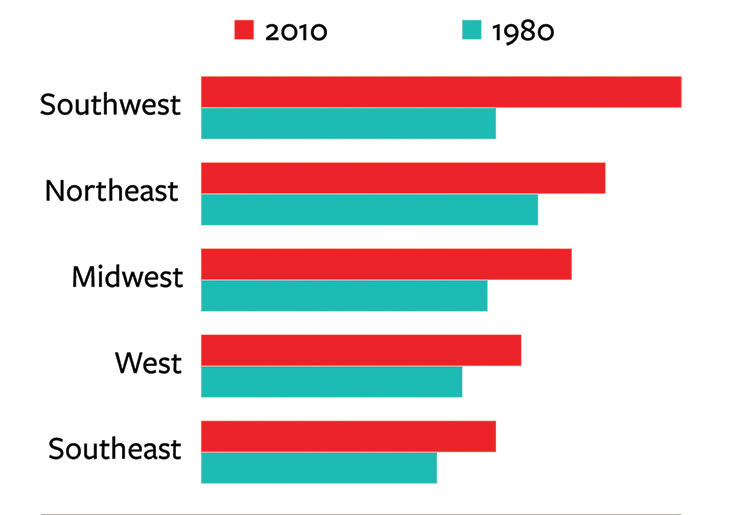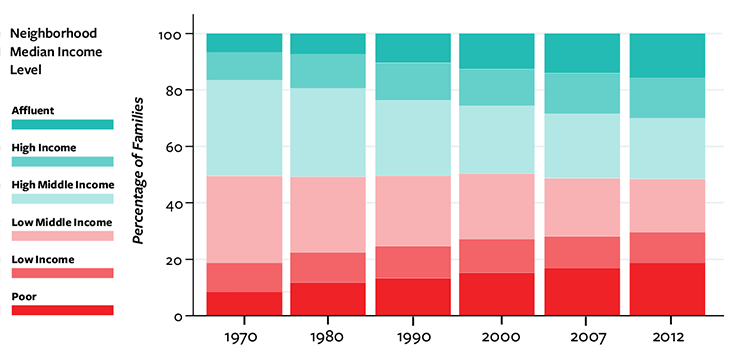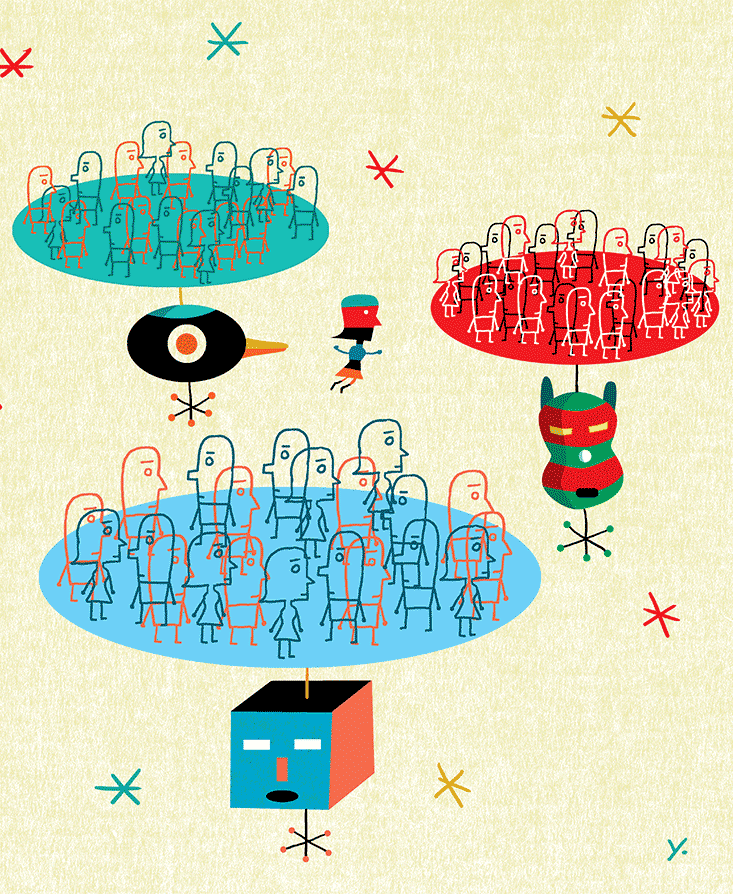When I see a liberal writer’s description of Donald Trump, or a conservative writer’s views of Hillary Clinton, I am embarrassed for them both. I wouldn’t let a 5-year-old child make such impolite and obviously extreme statements—and yet, today, extreme views are often applauded. They are a sign of an increase in polarization and political fragmentation that is happening across the United States.
The Pew Research Center has documented this shift over the last two decades, and shown that Democrats and Republicans have less and less in common with one another (see Drifting Apart).
These changes are visible in the social media sphere, too. There, fragmentation can be measured by identifying the political alignment of users and postings by how much they draw from familiar left-wing and right-wing sources (like Fox News on the right or The New York Times on the left), and then looking at how ideas and facts are shared across the ideological divide. Facebook researchers have found that most of their users are quite polarized, and don’t have many Facebook friends with opposing political views. Politically aligned users of the site also share very little in the way of news or opinion with those of opposite persuasion (see Let’s Not Talk).

In this way, social media makes it easier for users to develop a virtual peer community that supports unusual identity, beliefs, and behavior, and for extreme views to find support. This changes how we form our sacred beliefs, which are those beliefs that include “core constructs of national and ethnic identities and moral norms.”2 Such beliefs are the basis of our social identity—regardless of whether we are right or left leaning—and so are hard to change. Functional magnetic resonance imaging studies have shown that we process these sorts of beliefs in a region of the brain that is separate from those regions that handle our normal rational way of thinking, and without particular regard for utility.2
As a consequence, sacred beliefs are resistant to logic or evidence, because to question them is to damage our peer group membership, and undermine the social benefits we receive from it. The ability to maintain unusual identities leads to a fragmentation of our sacred beliefs and our political sphere, and increases the difficulty of obtaining consensual change.3, 4 The result is what Harvard law professor Cass Sunstein and his colleagues call a digital “echo chamber.”5
All of which sounds rather bleak. But there is another dimension to our segregated society that we sometimes forget about: where we physically live, and whom we move past on a day-to-day basis. It shouldn’t be a surprise that the physical world, too, is becoming increasingly segregated. But it also might offer a solution.

In recent decades, U.S. neighborhoods have become significantly more segregated by income. Data shows that more and more American families are living in neighborhoods where the majority is just like them: Poor families live in poor neighborhoods, and rich families live in rich ones (see Like with Like).
This is particularly problematic because our physical networks are a powerful influence on our beliefs. In 2008, my research group at the Massachusetts Institute of Technology studied interactions among a group of voters. We used cell-phone based Bluetooth proximity detection, WLAN location approximation and communication, and call records to put together an account of subjects’ face-to-face interactions, gathering 132,000 hours of social interaction data.
We found that face-to-face social exposure features explained individual political opinions on Election Day better than self-reported social ties or the views of people with whom they had political discussions. The best predictor of subject attitudes was not their friends, parents, or political discussants, but rather the attitudes of the peers who shared the same physical environment.
We have recently shown similar results in Europe and the Middle East.7 The voting behavior of people who work in the same area and shop at the same stores is more uniform than those of a given age, gender, or socioeconomic status. Not only do we seek out environments that have people like us (birds of a feather really do flock together!), but we unconsciously pick up attitudes and beliefs from the people we identify as peers. When in Rome, we begin to do as the Romans do—often without even being conscious of it. This runs counter to the common assumption in economics that people are independent and autonomous. The evidence is that people’s beliefs and actions are overwhelmingly determined through social learning from peers, whether we know it or not.


While in one sense this is just another facet of today’s increasingly polarized world, it also provides us with an opportunity. When we interact through social media, we self-identify and seek out like opinions. In real life, we have less control over that selection—we never know who we’ll run into. Physical interactions are also very powerful. They are much better at changing opinions than digital media. Studies show such interactions produce better learning outcomes,10 a greater chance of reaching consensus,11 and greater satisfaction in workplace teams.12
So what would happen if the way we interacted with each other forced us to mix with people of different groups? If we didn’t allow ourselves to dive ever deeper into self-reinforcing groups? What would happen if we mixed primarily through that quaint and old-fashioned technique, namely moving about in our physical environment, encountering opinions and perspectives that we did not pre-select? Could we counter the devil’s brew of single-community media combined with physical segregation? My research at MIT strongly suggests that the answer is yes. In businesses, on the street, and in peer groups, ideas are shaped more by face-to-face interaction than by digital media.13, 14
The benefits of physical mixing extend beyond reducing political fragmentation. The National Economics Review Board has noted that the segregation of poverty has a very strong negative association with upward mobility, whereas segregation of affluence does not. The National Bureau of Economic Research has also shown that in the U.S. the correlation between such spatial factors and upward mobility is two to three times stronger than the correlation with income inequality, school quality, or social capital. My own research group at MIT has shown that in both the U.S. and European Union, wealth is predicted by the diversity of face-to-face communication and that both poverty and crime levels are predicted by the isolation of a community.
As a case example, consider the Brownsville neighborhood of Brooklyn, which is one of the poorest neighborhoods in America. The federal, state, and city governments spend enormous amounts of money managing the effects of poverty there, but most of that money goes to middle-class workers who live outside of the neighborhood and operate the relevant prison, shelter, foster care, and hospital systems.
We could take a different approach to neighborhoods like Brownsville, one that targets mixing populations. The government could employ locals for services, improve transportation into and out of the neighborhood, and create tax breaks for industries that employ locals. With enough mixing, the old factions, with their conflicting sacred beliefs, might fade away and a more productive community dialogue could emerge.
So the next time you get mad at a tweet, or are upset by a news item about the growing inequality in our country, turn off your computer or TV, get up, and go talk to someone. For real.
Alex “Sandy” Pentland directs the MIT Connection Science and Human Dynamics labs and previously helped create and direct the MIT Media Lab. He is a member of the U.S. National Academy, a leader within the World Economic Forum, and one of the “7 most powerful data scientists in the world” according to Forbes.

References
1. Pew Research Center. Political polarization in the American public: How increasing ideological uniformity and partisan antipathy affect politics, compromise and everyday life. www.PewResearch.org (2014).
2. Berns, G. et al. The price of your soul: Neural evidence for the non-utilitarian representation of sacred values. Philosophical Transactions of the Royal Society B 367, 754-762 (2012).
3. Atran, S., Axelrod, R., & Davis, R. Sacred barriers to conflict resolution. Science 317, 1039–1040 (2007).
4. Powers, W. Who’s Influencing Election 2016? Medium.com (2016).
5. Quattrociocchi, W., Scala, A., & Sunstein, C. Echo Chambers on Facebook. Social Science Research Network (2016).
6. Bakshy, E., Messing, S., & Adamic, L. Exposure to diverse information on Facebook. Research.Facebook.com (2015).
7. Dong, X., et al. Purchase patterns, socioeconomic status, and political inclination. Annual Bank Conference on Development Economics 2016: Data and Development Economics, (2016).
8. Fry, R. & Taylor, P. The rise of residential segregation by income. www.PewSocialTrends.org (2012).
9. Reardon. S.F. & Bischoff, K. Income segregation in the United States’ largest metropolitan areas. Inequality.Stanford.edu (2016).
10. Johnson, S.D., Aragon, S.R., Shaik, N., & Palma-Rivas, N. Comparative analysis of learner satisfaction and learning outcomes in online and face-to-face learning environments. Journal of Interactive Learning Research 11, 29-49 (2000).
11. Slater, M., Sadagic, A., Usoh, M., & Schroeder, R. Small-group behavior in a virtual and real environment: A comparative study. Presence 9, 37-51 (2000).
10. Warkentin, M.E., Sayeed, L., & Hightower, R. Virtual teams versus face-to-face teams: An exploratory study of a web-based conference system. Decision Sciences 28, 975-996 (1997).
13. Pentland, A. Social Physics: How Social Networks Can Make Us Smarter Penguin Press, New York, NY (2014).
14. Rand, D.G., et al. Dynamic remodeling of in-group bias during the 2008 presidential election. Proceedings of the National Academy of Sciences 106, 6187-6191 (2009).






























